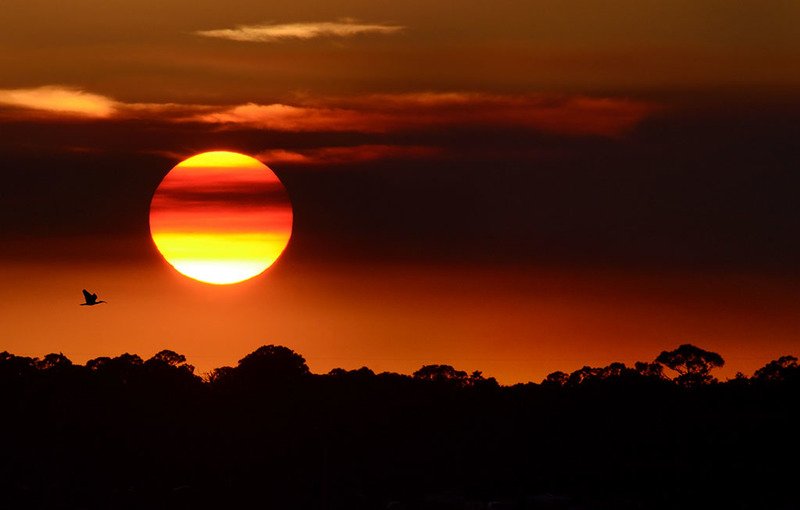The phenomenon of an orange sky is a captivating sight that can occur under various conditions. This striking color often emerges during specific times of the day or in the presence of atmospheric disturbances.
The sky appears orange because, at sunrise or sunset, sunlight travels through more of the atmosphere, scattering blue light and letting orange light dominate. Pollution and smoke can enhance this effect.
Understanding why the sky turns orange involves exploring the science of light scattering, the effects of pollution, and the impact of natural events.
What Causes The Sky To Appear Orange?
The sky appears orange due to the scattering of sunlight by particles and molecules in the atmosphere. This phenomenon, known as Rayleigh scattering, occurs when sunlight passes through the Earth’s atmosphere.
During sunrise and sunset, the sunlight has to travel through a thicker layer of the atmosphere compared to when the sun is overhead. This extended path scatters shorter wavelengths of light (blue and violet) more effectively, allowing the longer wavelengths (red, orange, and yellow) to dominate, giving the sky its orange hue.
Why Does The Sky Turn Orange During Sunrise And Sunset?

During sunrise and sunset, the sun is positioned low on the horizon, and its light travels through more of the Earth’s atmosphere. This longer path means more scattering of shorter wavelengths and less direct blue light reaching our eyes.
As a result, the sky takes on shades of orange, red, and pink. This effect is further intensified by the presence of aerosols and dust in the air, which can enhance the scattering process.
How Does Sunlight Affect The Color Of The Sky?
Sunlight is composed of various colors that correspond to different wavelengths. When sunlight enters the Earth’s atmosphere, it interacts with air molecules and particles. Blue light, having shorter wavelengths, is scattered more widely than the longer wavelengths such as orange and red.
During the day, this scattered blue light gives the sky its blue appearance. However, at sunrise and sunset, the increased travel distance through the atmosphere reduces the amount of scattered blue light and enhances the visibility of orange and red wavelengths.
When Does The Sky Look Most Orange?
The sky looks most orange during sunrise and sunset. These times of day provide the optimal conditions for the scattering of shorter wavelengths and the dominance of longer wavelengths.
Additionally, the sky can also appear orange when there are high levels of pollutants, dust, or smoke, which can further enhance the scattering of light and intensify the orange hue.
Read: Appfordown Appstore – Perfect For You In 2024!
What Role Does Pollution Play In Making The Sky Orange?
Pollution contributes to the orange appearance of the sky by adding additional particles to the atmosphere. These particles, including soot and aerosols, increase the scattering of sunlight.
This means that more of the longer wavelengths (red and orange) are scattered and less blue light reaches our eyes. As a result, the sky appears more intensely orange or red, especially during times when pollution levels are high.
Why Does Smoke Make The Sky Look Orange?

Smoke from wildfires or other sources contains fine particles and aerosols that scatter and absorb sunlight.
When the atmosphere is filled with smoke, these particles scatter shorter wavelengths of light more than longer wavelengths. This scattering effect makes the sky appear orange or even red. Additionally, dense smoke can reduce visibility, further enhancing the orange appearance of the sky.
How Do Particles In The Air Impact The Sky’s Color?
Particles in the air, such as dust, smoke, and pollutants, influence the color of the sky by affecting how sunlight is scattered.
Larger particles scatter light differently than smaller ones, and an increased number of particles in the atmosphere can intensify the scattering effect. This means that particles can enhance the orange and red hues of the sky by blocking and scattering the shorter blue wavelengths of light.
What Is Rayleigh Scattering And How Does It Relate To An Orange Sky?
Rayleigh dispersing is the dissipating of light or other electromagnetic radiation by particles a lot more modest than the frequency of the light. It is responsible for the blue color of the daytime sky and the red and orange hues of the sky during sunrise and sunset.
When sunlight travels through a thicker layer of atmosphere, as it does at sunrise and sunset, Rayleigh scattering results in a greater amount of scattering of shorter wavelengths, leaving longer wavelengths to dominate and create an orange or red sky.
Where Is The Sky Most Likely To Look Orange?
The sky is most likely to look orange in locations with high levels of atmospheric particles, such as urban areas with significant pollution, regions affected by wildfires, and during specific weather conditions like dust storms.

Additionally, during sunrise and sunset, the sky tends to exhibit more pronounced orange hues due to the increased atmospheric path length of sunlight.
Why Does The Sky Sometimes Stay Orange For Longer Periods?
The sky can remain orange for extended periods due to persistent atmospheric conditions. Factors like prolonged pollution, ongoing wildfires, or continuous dust storms can keep the particles in the atmosphere for longer durations, leading to a sustained orange appearance.
Additionally, weather patterns that trap pollutants close to the ground can also contribute to longer-lasting orange skies.
Read: Do You Prefer Having A Tour Guide For Travelling? – Read it!
Conclusion:
An orange sky happens because of how sunlight spreads through the atmosphere and interacts with particles in the air. It can be caused by natural changes in the atmosphere or by pollution and smoke. This beautiful color helps us understand more about our environment and how light works.
FAQ’s:
1. How Does City Light Affect an Orange Sky?
City lights can make the sky look orange at night by mixing artificial light with natural sunlight scattering.
2. Can Volcanoes Turn the Sky Orange?
Yes, volcanic eruptions can make the sky orange by sending ash and gases into the atmosphere that scatter sunlight.
3. Why Does the Sky Sometimes Look Orange During Certain Weather?
Weather conditions like high humidity or temperature changes can make the sky appear orange by affecting how light scatters.
4. Does the Season Change the Orange Color of the Sky?
Yes, different seasons can change the sky’s orange color. For example, autumn can enhance the orange hues during sunrise and sunset.
5. How Does the Sun’s Angle Affect the Orange Sky?
When the sun is low in the sky, like at sunrise or sunset, its light travels through more of the atmosphere, making the sky look more orange.
Read:




